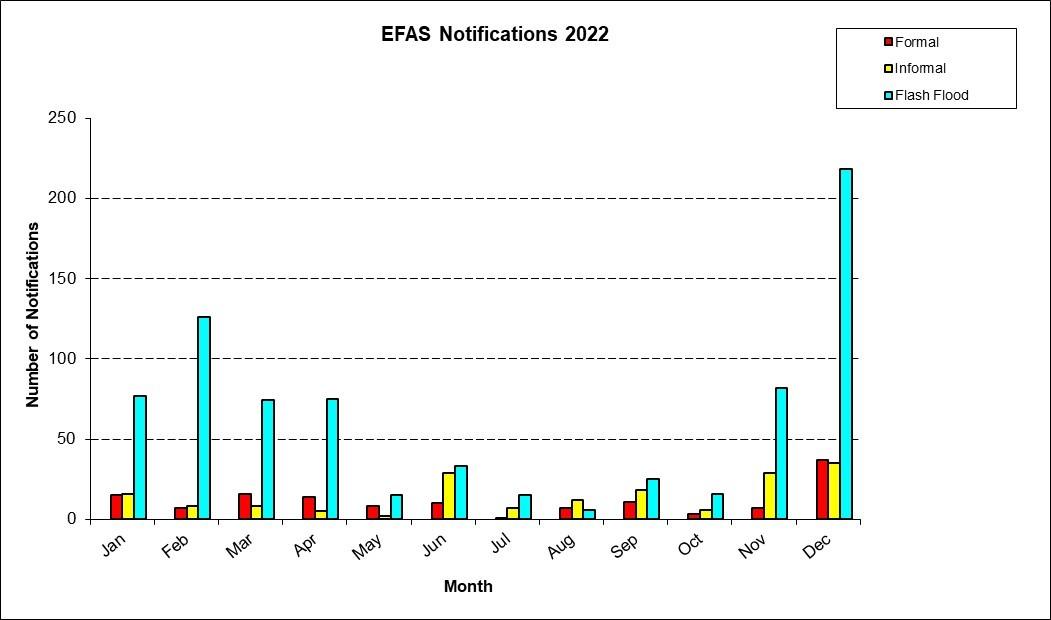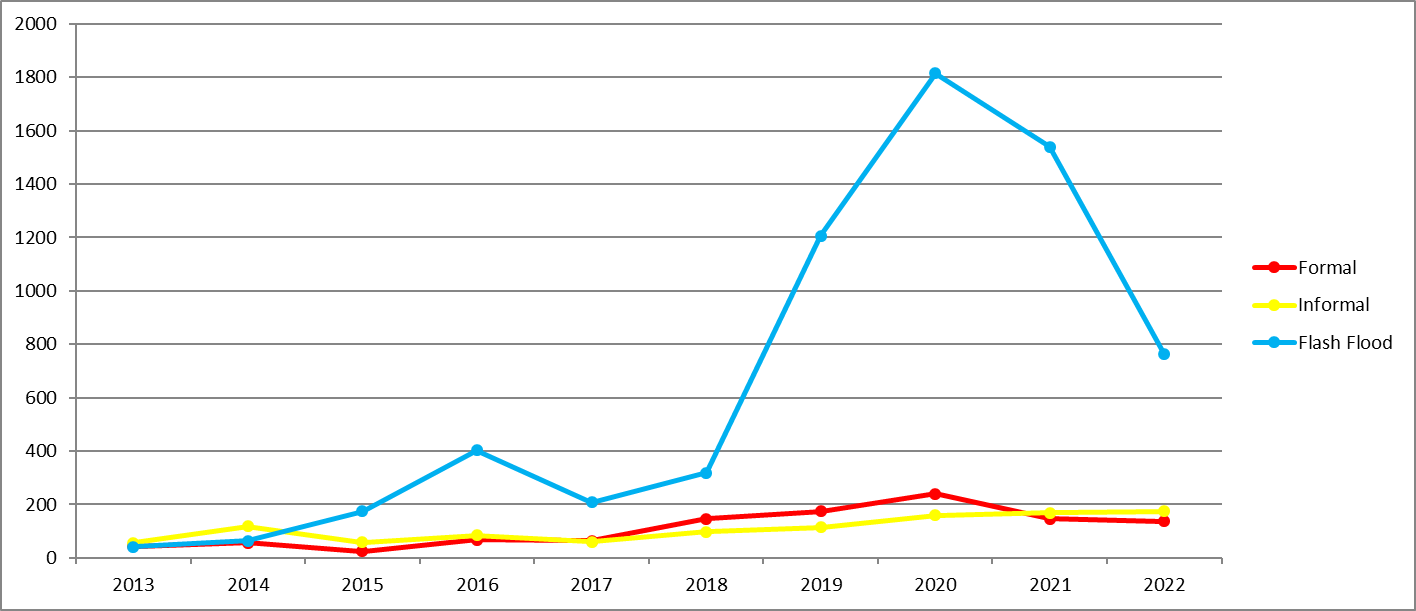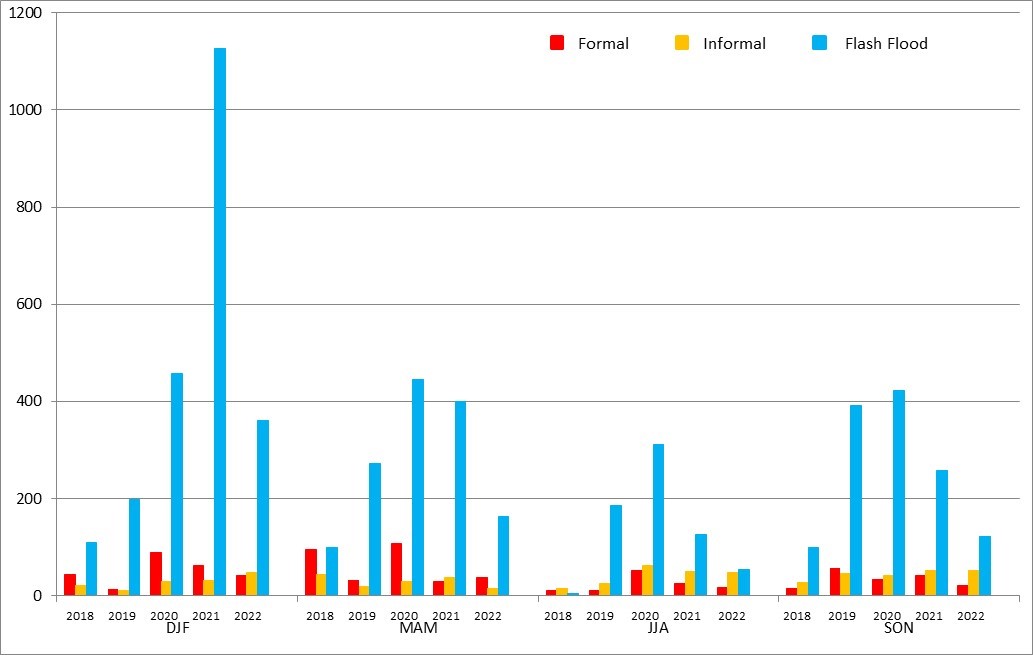
The Summary of EFAS Notifications in 2022 and comparison with previous years
by Eric Sprokkereef (RWS)
Figure 1 shows the number of formal, informal and flash flood notifications issued each month throughout 2022. With a total number of 1084 EFAS notifications in the year 2022 the amount of notifications decreases by about 42% compared to the previous year. The year 2022 has the lowest number of notifications since 2019. Compared to 2021, the EFAS Dissemination Centre (DISS) issued 7% less formal, 4% more informal and 50% less flash flood notifications. December was the most active month with 290 notifications, which is about 27% of the annual sum for 2022. December saw the highest number of all three types of notifications, whereas the months May till October were extremely quiet in terms of flood notifications. In total 137 formal, 175 informal and 772 flash flood notifications were issued in 2022.
Remarkable periods in 2022 were:
- Storm Franklin causing floods in Northern Europe in February
- Southern and Central Spain early May
- France May to early June
- Austria in June
- Northern Italy in August
- Portugal, Spain, Italy and Croatia in September
- Greece in October
- Scotland and the UK in November
- Portugal and Spain in December
For comparison, Figure 2 indicates the total number of EFAS notifications per year for the past 10 years. 2022 was relatively ‘normal’ for formal and informal notifications. The number of flash flood notifications decreased significantly compared to 2021.

Figure 2: Total number of EFAS formal (red), informal (yellow) and flash flood (blue) notifications issued per year from 2013-2022
Figure 3 breaks down the number of notifications over the past 5 years into seasons (December-January-February [DJF], March-April-May [MAM], June-July-August [JJA] and September-October-November [SON]).
Excluding the extremely high number of flash flood notifications in January and February 2021, there is little difference between winter, spring and autumn. The number of notifications in the summer months is significantly lower. If one only looks on formal and informal notifications, then the most active seasons were the spring of 2018, the winter, spring and summer of 2020.

Figure 3: Number of EFAS formal (red), informal (yellow) and flash flood (blue) notifications issued per season over the past 5 years (2018-2022)
Based on the number of notifications issued from 2018-2022, the most formal flood notifications are issued in spring (60 per year on average), the most informal flood notifications in autumn (44 per year on average) and the most flash flood notifications in winter (450 per year on average). The figure for flash flood notifications is distorted due to the adjustment of the issuance criteria from February 2021.The season with the lowest amount of formal notifications is the summer (24 per year on average).
In 2022 in total 37 countries received 1084 notifications (137 formal, 175 informal and 772 flash flood notifications). Spain received the highest number of notifications (20 formal, 11 informal and 106 flash flood notifications). The highest amount of formal notifications has also been sent to Spain (20), followed by Italy (13). The highest amount of informal notifications was sent to Italy (34), followed by Greece (18), and the highest amount of flash flood notifications to Spain (106) and Romania (72).
In 2022 EFAS DISS has continued with the analysis of the results from the floodlist information system (https://floodlist.com/) on an operational basis, using the Global Reporting Tool (GRT). Reported flood situations for large river basin throughout the world were analyzed on a daily basis Verified information was released for publication on the Global Disaster Alerting Coordination System (GDACS; https://www.gdacs.org/) that is used by the UN and the EU to coordinate disaster relief actions. In total 923 flood reports have been verified and released for publication in GDACS by EFAS DISS in 2022. 133 events occurred in Africa, 267 in Asia, 189 in Europe, 145 in North America, 161 in South America, and 28 in Australia and Oceania. The total amount of 2022 is comparable to 2021.

